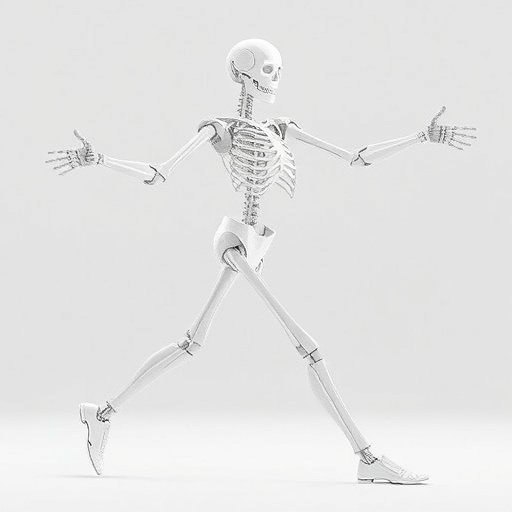In a groundbreaking study, researchers have introduced an innovative tool designed for analyzing musculoskeletal inverse kinematics using inertial motion capture data. This new implementation, based on the Adaptive Unscented Kalman Smoother, aims to enhance the precision and efficiency of biomechanical assessments, particularly for applications in rehabilitation and athletic performance analysis. The tool is tailored for integration with OpenSim, a widely used platform for musculoskeletal modeling and simulation.
The backdrop of this research lies in the growing need for accurate motion capture techniques in biomechanics. Traditional methods of capturing and analyzing human movement often face limitations due to issues such as sensor drift and environmental interference. The new tool addresses these challenges by leveraging advanced algorithms that refine the data collected from inertial sensors, ensuring that the resulting kinematic models are both reliable and robust.
One of the pivotal strengths of the Adaptive Unscented Kalman Smoother lies in its ability to predict the future states of a system while accounting for noise in the measurements. This feature allows for real-time processing of motion data, which is essential in dynamic environments where athletes or patients may exhibit unpredictable movements. The researchers assert that this capability significantly reduces the lag often associated with traditional filtering techniques, facilitating quicker response times during biomechanical assessments.
The implications of this work extend beyond the laboratory into a variety of practical applications. Athletes can benefit from precise feedback on their biomechanics, allowing for tailored training regimens that enhance performance while reducing the risk of injury. Additionally, rehabilitation professionals can employ the tool to monitor patient progress with greater accuracy, adjusting treatment plans based on detailed movement analyses.
With the tool being implemented in OpenSim, the accessibility of advanced motion analysis is poised to expand dramatically. OpenSim itself serves as a platform for researchers and practitioners to create and customize musculoskeletal models, making it an ideal environment for the integration of the new kinematic tool. This compatibility ensures that users can easily apply advanced motion capture methods without the need for extensive software training or modifications.
The research team’s thorough validation process further underscores the tool’s credibility. By conducting extensive tests across various motion scenarios, the researchers demonstrated that the Adaptive Unscented Kalman Smoother effectively reduces errors associated with traditional motion capture methods. The findings indicate that the new approach can handle the complexities of human movement with remarkable precision, marking a significant leap forward in biomechanical analysis.
Moreover, the potential for widespread adoption of this technology in clinical settings is immense. Physical therapists and orthopedists can utilize the insights gained from the motion capture data to devise more effective rehabilitation strategies. The enhanced tracking of movement patterns can aid in identifying underlying issues and tailoring interventions, ultimately leading to improved patient outcomes.
Another factor contributing to the tool’s promise is its versatility. The Adaptive Unscented Kalman Smoother can be adapted for various sensors beyond inertial motion capture systems. This flexibility enables researchers to explore new avenues in motion analysis, potentially broadening the scope of biomechanical studies and therapeutic applications.
As the world of sports science continues to evolve, innovations like this musculoskeletal inverse kinematics tool will help bridge the gap between theoretical research and real-world application. The researchers are optimistic that their findings will inspire further advancements in motion capture technology, leading to enhanced performance monitoring and injury prevention strategies across numerous physical disciplines.
In conclusion, the introduction of this Adaptive Unscented Kalman Smoother-based tool represents a significant advancement in the field of biomechanics. By improving the accuracy and reliability of kinematic analyses for various applications, the researchers have laid the groundwork for future innovations that can benefit athletes, patients, and the broader scientific community. This groundbreaking research not only promises to refine the methodologies used in motion analysis but also stimulates further exploration of the complexities of human movement.
In the wake of this publication, it will be intriguing to observe how this tool is adopted and utilized in both clinical and sports settings. The ongoing collaboration between researchers and practitioners will likely yield further refinements and adaptations of the technology, pushing the boundaries of what is possible in biomechanical analysis. The future of motion capture and biomechanics is indeed bright, with promising advancements driven by innovative research like this one.
Subject of Research: Musculoskeletal inverse kinematics tool for inertial motion capture data using Adaptive Unscented Kalman Smoother.
Article Title: Musculoskeletal Inverse Kinematics Tool for Inertial Motion Capture Data Based on the Adaptive Unscented Kalman Smoother: An Implementation for OpenSim.
Article References:
Kortelainen, M.J., Vartiainen, P., Beattie, A. et al. Musculoskeletal Inverse Kinematics Tool for Inertial Motion Capture Data Based on the Adaptive Unscented Kalman Smoother: An Implementation for OpenSim. Ann Biomed Eng (2025). https://doi.org/10.1007/s10439-025-03807-x
Image Credits: AI Generated
DOI:
Keywords: Inverse Kinematics, Motion Capture, Kalman Smoother, OpenSim, Biomechanics, Rehabilitation, Athletic Performance, Human Movement Analysis.




